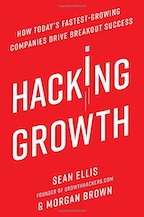Book Summary of 'Hacking Growth'
by Sean Ellis and Morgan Brown

What is this book about?
"Hacking Growth" is a guide to the strategies and tactics used by some of today's fastest-growing companies to achieve breakout success. The book introduces the concept of "growth hacking," a methodology that combines data-driven marketing with product development to drive rapid, sustainable growth. It emphasizes the importance of cross-functional teams that blend marketing, product development, data analysis, and engineering to continuously experiment and refine strategies for customer acquisition, activation, retention, and monetization.
Who should read the book?
This book is ideal for entrepreneurs, marketers, product managers, startup founders, and anyone involved in growing a business or a product. It is also useful for executives at larger companies looking to foster innovation and growth through modern, agile approaches to marketing and product development.
10 Big Ideas from the Book
- Growth Hacking Methodology: The book outlines a systematic approach to growth that involves forming cross-functional teams, conducting rapid experiments, and using data to make informed decisions.
- Product-Market Fit: Achieving a "must-have" status with customers is crucial. The book emphasizes the importance of finding and refining this fit.
- High-Tempo Testing: Rapid experimentation is key to discovering what drives growth. The book advocates for constant testing and iteration.
- Cross-Functional Teams: Growth teams should break down silos between marketing, product development, and engineering to foster collaboration and innovation.
- Customer-Centric Approach: Understanding customer behavior and feedback is vital for developing products that meet real needs and drive retention.
- Data-Driven Decisions: Growth hacking relies heavily on data to guide decisions, test assumptions, and measure success.
- Viral Loops and Network Effects: Leveraging the viral potential of products can significantly accelerate growth, as demonstrated by companies like Dropbox and Airbnb.
- Retention Over Acquisition: Retaining and monetizing existing customers is often more valuable than acquiring new ones. The book focuses on strategies to keep customers engaged.
- Scalable Growth Strategies: The book highlights the importance of finding scalable growth levers that can be systematically optimized and expanded.
- Continuous Improvement: Growth hacking is not a one-time effort but a continuous process of learning, adapting, and improving.
Summary of Key Insights from "Hacking Growth"
1. Growth Hacking as a Methodology
- Insight: Growth hacking is a data-driven methodology aimed at rapidly growing a business or product by combining marketing and product development. It's about finding scalable and repeatable ways to grow.
- For Entrepreneurs: Understand that growth hacking is not just about marketing but involves every aspect of your business. As an entrepreneur, adopting a growth mindset is crucial for the long-term success of your startup.
- For Product Managers: Embrace growth hacking as a continuous process that influences product development. Collaborate closely with marketing and engineering teams to drive growth through product features.
2. Cross-Functional Teams
- Insight: Successful growth hacking requires breaking down silos between departments. The most effective growth teams include members from marketing, product, engineering, and data analytics.
- For Entrepreneurs: Build a culture of collaboration within your company. Ensure that your teams are aligned with common growth goals and are empowered to work together.
- For Product Managers: Work closely with other departments to ensure that growth strategies are integrated into the product roadmap. Your role is pivotal in ensuring the product evolves in a way that supports growth objectives.
3. High-Tempo Testing
- Insight: Rapid experimentation is key to discovering what drives growth. Growth hackers continuously test, learn, and iterate on their strategies.
- For Entrepreneurs: Encourage a culture of experimentation. Understand that failure is part of the process and each experiment is a learning opportunity.
- For Product Managers: Incorporate A/B testing and other experimental approaches into the product development cycle. Use data from these tests to inform future product decisions.
4. Product-Market Fit
- Insight: Achieving product-market fit is critical. This means ensuring that your product addresses a real need for a significant number of users, making it a "must-have."
- For Entrepreneurs: Focus on understanding your customers deeply and ensure your product solves a critical problem for them. Only when you have a strong product-market fit should you scale.
- For Product Managers: Constantly evaluate whether the product is meeting the needs of the market. Use customer feedback and data analysis to refine and enhance the product to better fit market demands.
5. Data-Driven Decision Making
- Insight: Data is at the heart of growth hacking. Every decision, from product development to marketing campaigns, should be backed by data and analytics.
- For Entrepreneurs: Invest in the tools and talent needed to collect and analyze data effectively. Use this data to guide your strategic decisions.
- For Product Managers: Ensure that your product decisions are informed by user data. Regularly analyze how users interact with the product and use these insights to drive improvements.
6. Viral Loops and Network Effects
- Insight: Leveraging viral loops (where users refer others to the product) and network effects (where the product becomes more valuable as more people use it) can significantly accelerate growth.
- For Entrepreneurs: Design your product and marketing strategies to encourage viral growth. This could be through referral programs, social sharing features, or incentivizing user-generated content.
- For Product Managers: Integrate features that encourage users to share the product with others. Analyze the viral coefficient (how many new users each user brings in) to optimize these efforts.
7. Retention Over Acquisition
- Insight: Retaining existing customers is often more valuable than acquiring new ones. A strong focus on customer retention can lead to sustainable growth.
- For Entrepreneurs: Don’t just focus on getting new customers. Develop strategies to keep existing customers engaged and satisfied, as they are more likely to provide recurring revenue and positive word-of-mouth.
- For Product Managers: Work on enhancing the user experience to improve retention rates. This might involve simplifying the onboarding process, providing continuous value through updates, or improving customer support.
8. Monetization Strategies
- Insight: Growth hacking isn’t just about acquiring users; it's also about finding ways to monetize them effectively. This involves understanding customer lifetime value (CLTV) and optimizing pricing models.
- For Entrepreneurs: Explore different monetization strategies, from freemium models to subscription services. Continuously test and refine pricing strategies to maximize revenue.
- For Product Managers: Analyze user behavior to identify the most profitable segments and focus product features that enhance value for these users. Consider testing different monetization options to see what works best.
9. Scalable Growth Levers
- Insight: Identify and optimize scalable growth levers—actions or features that can be scaled up to drive significant growth.
- For Entrepreneurs: Focus on finding growth levers that are cost-effective and can be scaled. This could involve leveraging technology, automating processes, or finding unique distribution channels.
- For Product Managers: Identify which product features or user actions have the most significant impact on growth. Work on enhancing these aspects of the product to amplify their effect.
10. Continuous Improvement and Learning
- Insight: Growth hacking is an ongoing process. Continuous improvement and learning are essential to sustaining and accelerating growth over time.
- For Entrepreneurs: Stay committed to learning and improving. The market and technology are always changing, so your growth strategies must evolve too.
- For Product Managers: Regularly review product performance and user feedback. Use this information to drive continuous improvement in the product, ensuring it stays competitive and meets user needs.
Learnings for Entrepreneurs
- Adopt a growth mindset: Be open to experimenting with new ideas and learning from both successes and failures.
- Build collaborative teams: Foster an environment where cross-functional teams can work together effectively.
- Prioritize product-market fit: Ensure your product is truly needed by the market before scaling up.
- Invest in data: Make data-driven decisions a cornerstone of your business strategy.
Learnings for Product Managers
- Collaborate across departments: Work closely with marketing, engineering, and data teams to drive growth.
- Focus on retention: Develop features that keep users engaged and coming back.
- Use data to guide development: Let user data inform your product decisions to create a better user experience.
- Iterate quickly: Embrace a fast-paced cycle of testing and learning to continuously improve the product.
By integrating these insights into their work, both entrepreneurs and product managers can drive sustained and scalable growth, ensuring the long-term success of their businesses and products.
Which Other Books are Used as Reference?
The text references methodologies from other influential books, including:
- "Lean Startup" by Eric Ries: Emphasizes the importance of rapid prototyping, customer feedback, and iterative product development.
- "Agile Development" principles: These are mentioned as influencing the growth hacking process, particularly the emphasis on speed and adaptability.
- "The Innovator's Dilemma" by Clayton Christensen: Concepts from this book might be echoed in discussions about innovation and disruption.
These references provide a foundation for the strategies discussed in "Hacking Growth," tying them to broader trends in startup and product development methodology.
Related Books - Startup and Entrepreneurship
| No | Book | Author |
|---|---|---|
| 1 | The Lean Startup | Eric Ries |
| 2 | The Innovator's Dilemma | Clayton M. Christensen |
| 3 | Built to Last | James C. Collins and Jerry I. Porras |
| 4 | Zero to One | Peter Thiel |
| 5 | Explosive Growth | Cliff Lerner |
| 6 | The Nuclear Effect | Scott Oldford |
| 7 | The Millionaire Fastlane | MJ DeMarco |
| 8 | Zero To Sold | Arvid Kahl |
| 9 | Built to Sell | John Warrillow |
| 10 | Getting Acquired | Andrew Gazdecki |
| 11 | Doglapan | Ashneer Grover |
| 12 | The $150M Secret | Guillaume Moubeche |

